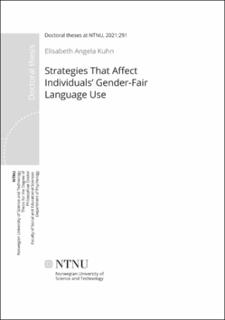| dc.contributor.advisor | Gabriel, Ute | |
| dc.contributor.author | Kuhn, Elisabeth Angela | |
| dc.date.accessioned | 2021-10-21T11:15:37Z | |
| dc.date.available | 2021-10-21T11:15:37Z | |
| dc.date.issued | 2021 | |
| dc.identifier.isbn | 978-82-326-5473-4 | |
| dc.identifier.issn | 2703-8084 | |
| dc.identifier.uri | https://hdl.handle.net/11250/2824479 | |
| dc.description.abstract | Language reproduces and produces gender and reality, hence plays a significant role in pursuing an equitable society without discrimination based on gender categories. The promotion of gender-fair language through feminization and neutralization strategies has led to an increase in the use of gender-fair language in recent decades. The change strongly affected formal texts yet only partially influenced everyday language use. In order to further encourage gender-fair language use, it is crucial to better understand what affects individuals’ gender-fair language use.
Gender-fair language use is the result of a complex language production process that must be understood in a social context. Accordingly, this thesis was based on written language production and employed both a social-cognitive (motivation and opportunity as determinants model) and a social-interaction perspective (communication accommodation theory) to identify relevant factors that on the one hand could explain individuals’ current gender-fair language use and on the other hand how individuals can change and adapt toward more gender-fair language use. Concerning deliberate language use, language competence, the ability to use gender-fair language, and motivation to use accurate language were identified as relevant elements. Regarding automated processes implicit and explicit exposure to gender-fair language and the prevalence of word forms were investigated.
Six experiments (four in German; two in Norwegian) were conducted. To operationalize key concepts new materials and scales needed to be developed, such as text materials in gender-fair and gender-biased forms. Experiments were conducted with samples of university students and trainees and either paper-and-pencil or online.
Results did not support a relation between gender-fair language use and general language competence or motivation to use accurate language. Explicit instruction increased individuals’ gender-fair language use but did not result in exclusive use of gender-fair language. Implicit exposure to gender-fair language (reading) leads in the Norwegian samples and in the female German samples to an increase in gender-fair language use. Explicit exposure (being made aware that a text is formulated in a genderfair manner) leads in the male German sample to an increased use of gender-fair language. With reference to word forms, participants tended to select the more prevalent form.
In sum, the findings of the present study suggest amongst the investigated strategies to promote gender-fair language the most effectives are giving instructions and exposing people to—and making them aware of—gender-fair language. These approaches can create a cascade effect, those who use gender-fair language expose other people to its use, which in turn can lead to them using gender-fair language, again exposing others. As gender-fair forms become more prevalent, individuals can access them more easily and, as such, are more likely to use them. | en_US |
| dc.language.iso | eng | en_US |
| dc.publisher | NTNU | en_US |
| dc.relation.ispartofseries | Doctoral theses at NTNU;2021:291 | |
| dc.relation.haspart | Paper 1: Gabriel, Ute; Gygax, Pascal M.; Kuhn, Elisabeth Angela. Neutralising linguistic sexism: Promising but cumbersome?. Group Processes & Intergroup Relations 2018 ;Volum 21.(5) s. 844-858 https://doi.org/10.1177/1368430218771742 | en_US |
| dc.relation.haspart | Paper 2: Kuhn, Elisabeth Angela; Gabriel, Ute. Actual and potential gender-fair language use: The role of language competence and the motivation to use accurate language. Journal of Language and Social Psychology 2014 ;Volum 33.(2) s. 214-225 https://doi.org/10.1177/0261927X13504297 | en_US |
| dc.relation.haspart | Paper 3: Koeser, Sara; Kuhn, Elisabeth Angela; Sczesny, Sabine. Just Reading? How Gender-Fair Language Triggers Readers’ Use of Gender-Fair Forms. Journal of Language and Social Psychology 2015 ;Volum 34.(3) s. 343-357 https://doi.org/10.1177/0261927X14561119 | en_US |
| dc.relation.haspart | Paper 5: Kuhn, E. A., Koeser, S., & Gabriel, U. Spreading the gender-neutral word: Recency and prevalence effects in Norwegian gender-marked and unmarked role nouns. | en_US |
| dc.title | Strategies That Affect Individuals’ Gender-Fair Language Use | en_US |
| dc.type | Doctoral thesis | en_US |
| dc.subject.nsi | VDP::Social science: 200::Psychology: 260 | en_US |

